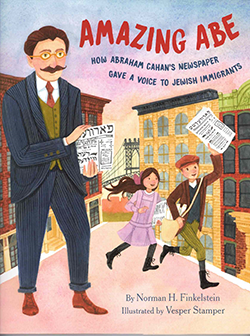Amazing Abe: How Abraham Chan’s Newspaper Gave a Voice to Jewish Immigrants by Norman H. Finkelstein, illustrated by Vesper Stamper; New York: Holiday House © 2024; ISBN 9780823-451647; 37 pages, $25.99

 SAN DIEGO – This is the story of the editor of the Forverts, known in English as the Jewish Daily Forward, as told for second- and third-graders by teacher Norman H. Finkelstein and illustrator Vesper Stamper, who respectively are a previous National Jewish Book Award winner and a finalist.
SAN DIEGO – This is the story of the editor of the Forverts, known in English as the Jewish Daily Forward, as told for second- and third-graders by teacher Norman H. Finkelstein and illustrator Vesper Stamper, who respectively are a previous National Jewish Book Award winner and a finalist.
The story pictures Abe Cahan growing up in Lithuania, becoming a teacher and an anti-czar political activist who for his safety flees to New York, teaching himself English en route. He perfected his English as a pupil in a class with middle schoolers. Like other immigrants, he worked in a dirty factory. He continued his education at night. Once he mastered English, he became a reporter for English-language newspapers specializing in coverage of his fellow immigrants.
In 1897, he helped to found the Forverts, becoming its editor in 1903, when he was 43. He continued in that position for 43 years, making the Yiddish-language newspaper not only a purveyor of Jewish news but an advocate for immigrant rights. The newspaper also taught new immigrants about American folkways—dishing out advice on such diverse topics as how baseball is played, how Americans set their tables, and to sneeze into handkerchiefs to avoid spreading germs in crowded tenements.
He wrote a advice column called A Bintel Brief long before “Dear Abby” became popular. In one instance, he advised a teenager to continue getting an education so she could get a better-paying job to help her family. A young girl who had tuberculosis asked where she could go for an affordable cure; Forverts readers responded by sending money.
In the illustrations, we watch Abe age from a boy to a young man to an impeccably dressed adult with a bowler hat, glasses and a waxed mustache. The locales are meticulously drawn to provide a glimpse of the rhythms of life in 19th- century Vilnius and 20th-century New York City, with clothing styles matching the eras and the locales.
For parents, there are appendices providing more of Cahan’s biography; a note from Finkelstein about his memories of fetching the Forverts from a stand at the local deli for his parents and grandparents to read; background on the Yiddish language; and one bibliography for adults and another for children about Cahan and his immigrant world.
*
Donald H. Harrison is the publisher and editor of San Diego Jewish World. He may be contacted via donald.harrison@sdjewishworld.com